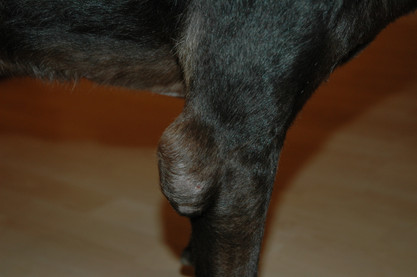11/19/2022
How DogLeggs Is Treating Elbow Hygromas
Do you know the warning signs of a hygroma? Better question - do you know what a hygroma is and what to do if you see one on your furry best friend? If your answer is no, you’re not alone and you are in the right place. This blog will explain what a hygroma is, early signs for early detection, and what to do if you spot one on your dog’s hips, ankles, or elbows. Since elbow hygromas are most common, this blog will specifically focus on this area.
Oh, and if you answered yes and you do in fact know what a hygroma is and what to do if you find one on your four-legged companion - skip down to learn about the DogLeggs innovation that is leading the way in hygroma treatment.
Okay, now let’s talk about the topic at hand - elbow hygromas.
What Is a Hygroma?
A hygroma is the medical name for a pocket of fluid that develops under the skin and over the protuberance of bone. The most common areas for a hygroma to form on a dog is over the hips, ankles (known as “hocks”), and elbows. The latter of which is by far the most common and also the most challenging as most dogs prefer to rest on their elbows.
Elbow hygromas are most common in large, short-coated dogs like labs, Great Danes, Rottweilers, and Boxers, and they appear most often during the summer months. As the heat index climbs, dogs seek out cooling comfort by laying on cool surfaces, which tend to be harder than say a carpet, rugg, or grass. As dogs rest on their elbows on hard surfaces, the pressure from their body weight also rests upon their elbows. When this pressure pushes their elbows down onto a hard surface, inflammation develops in the tissue that lays over the elbow. This inflammation then stimulates a fluid effusion under their skin.
Not a Callus
It’s important to note that a hygroma is not a callus. Though hygromas are often mistaken for a callus, this mistake is what leads many dog owners to dismiss this much more serious condition. A callus is a hairless area of thickened skinned that is caused by a chronic irritation, not an inflammation. It’s the skin's natural way of protecting itself against constant friction by strengthening these vulnerable and targeted areas.
That being said, a callus can sometimes be indicative of a larger problem, like a hygroma, especially if it forms on your dog's elbow and your dog frequently rests on their elbows on a hard surface. While separate conditions, hygromas commonly form underneath a callus.
Formation
A hygroma in the early stages of development is no more than a soft swelling at the point of the elbow. If detected at this stage, you can prevent a lot of pain for your dog and a lot of stress for yourself.
Complications arise when a hygroma suprasses the early stage of development and eventually ruptures which creates an open wound that is prone to infection. Healing an open wound on one of the most mobile areas on your dog’s body is incredibly difficult, as the healing progress is disrupted every time your dog moves the infected leg, which is seemingly anytime your dog moves their paws. This only causes your dog more discomfort and constant licking is the natural instinct for dogs in discomfort, which only further hinders the healing process.
Treatment
Once the hygroma ruptures and creates an open wound, some degree of surgery is inevitable. To what degree is dependent upon how your veterinarian views the severity of the problem at hand. And surgery is not the end. Your dog’s surgical site will need to heal and the before-mentioned problems - movement causing discomfort which causes constant licking - remina in play. This makes for one seriously frustrating post-surgical recovery.
Despite the challenges you and your dog face in recovery, it’s almost always advised to undergo surgery as failing to resolve an ulcerated hygroma can lead to the worsening of an increasingly threatening infection.
You now likely see the dilemma of hygromas. The fact is that there is no simple answer to this problem that stems from the most ordinary and common origins of your dog doing nothing but laying on a cool, hard surface. The only real solution is early detection which can lead to early treatment, which usually does not require surgery. So keep an eye on where your dog is laying and do your best to entice them to lay on soft ground or padding instead of hard surfaces.
DogLeggs to the Rescue
Okay, so here’s some good news for you. While hygromas can be a major problem, DogLeggs has a preventative solution that trumps the only other solution of early detection. And best of all - it’s incredibly effective.
While DogLeggs now offers a complete line of protective gear for both dogs and cats, our namesake product “Dogleggs” is where our story began, and it’s a story that really began with a 10 year old Rottweiler named Greif who developed a hygroma. This wasn’t your typical hygroma. No, this one was nasty and it caused pain and swelling that extended down Greif’s forelimbs and into his toes.
Greif’s Vet suggested adapting a human knee pad to protect his elbows when lying down. After just two days of Greif willingly wearing the first DogLeggs prototype - his swelling was reduced by half. After the fifth day, his swelling was completely gone and Dogleggs was born.
The Complete Line of Protection Gear for Dogs and Cats
The DogLeggs elbow coverage product is so effective and needed that it has sold well over 20,000 pairs. Today, Greif’s memory lives on through the paw prints on every product in DogLeggs’ complete line of protective gear for dogs and cats.
You can purchase most of the protective products on our website, but some require a prescription from your pet’s veterinarian. All DogLeggs products are designed with the structure and movement of cats and dogs in mind, but it’s best to consult with your vet to ensure that a particular product is the right fit for your pet.
DogLeggs products are made right here in the USA and come with a 100% Satisfaction Guarantee. And best of all, DogLeggs products are covered by most pet insurance companies when prescribed by your vet.
Protecting your dog from potential injury is critical as they age, especially when it comes to an injury like a hygroma. Your dog will be well-protected from hygromas with a pair of dogleggs, and of course, well-loved by you.


